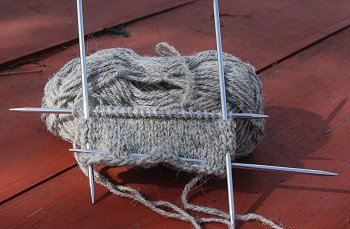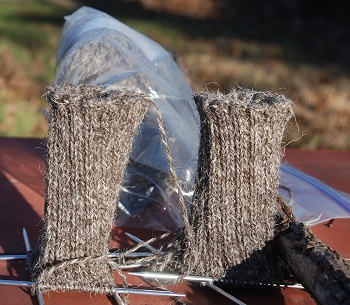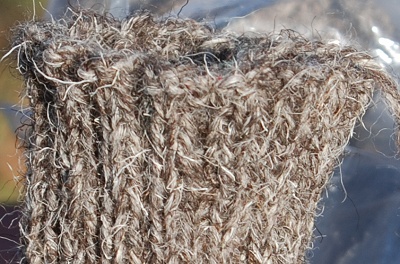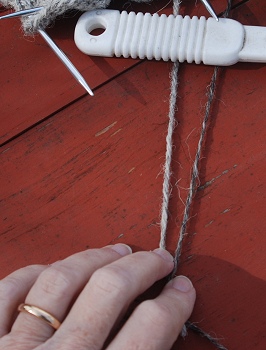The Herdwick yarn I bought is exactly what I hoped for–a yarn that belongs in a fantasy novel, in that its feel (like the breed itself) is old, traditional, and suits a rugged pre-industrial setting. Here’s a small swatch knitted on US #5, (3.75mm) needles, from the Aran-weight, light-colored yarn. I’m getting five stitches per inch.
Below are the tops of the first pair of Herdwick socks–five inches of 2×2 ribbing–in the worsted-weight marled yarn, also on the #5 needles. They flare out at the top because I cast on socks on #7 US (4.50 mm) to avoid them digging into my leg and leaving a groove. I did not swatch this yarn before starting the socks, just measured the first three rows on my leg, so I don’t have a proper gauge yet, but it feels (when pulled onto my leg) about like ordinary worsted, or six and a half stitches to the inch. For authenticity I should have it on wooden needles, but…I don’t.
You can see the “hairy” quality of this yarn at the top and left-hand side of the sock columns. Oddly (oddly to me) it doesn’t feel harsh. The central core of the yarn is firmly spun, and feels almost like string, not modern 100% wool yarn. The hairiness can make it tricky at first to see the core, but the knack comes quickly; the actual yarn is easy to feel and doesn’t split readily. While I can yank ordinary worsted apart with my hands, this yarn does not give to a strong sharp tug. The lanolin in it soothes my fingers as I knit. The only difficulty I’ve had was when I made a mistake and wanted to diagnose the error…the hairy fuzz made it hard to see into the stitch. Despite that, when I needed to tink back several stitches, they came undone cleanly, and re-knitted smoothly. I’d say without getting any hairier or fuzzier, but how could you tell, really?
You would not want to waste the effort to do fancy textured stitches…stitch definition is not outstanding. On the other hand, I like the rugged effect and the color effect a lot. It’s interesting, in a good way. I can easily imagine people in Paksworld dressing in cloth woven of yarn just a little finer than this, wearing socks and caps and mitts or gloves knitted of this. I can imagine it dyed various colors, especially the lighter colored yarn. A friend of mine has been experimenting lately with dying yarn using food coloring.
A side by side comparison of the Aran-weight yarn and the marled worsted-weight yarn:
The Aran-weight knitted on #5 needles produces a dense, slightly stiff fabric. I haven’t yet decided whether to try it as very heavy socks, or go up several needle sizes and use it as part of a vest. As a sweater or sweater-coat, it would be handsome and very warm–possibly too warm for my area, but great for the north.
Knitters interested in doing period costumes could certainly use the worsted-weight Herdwick for socks, fingerless mitts, shawls, etc. I suspect these will be superb hiking socks; the Aran-weight might be good for severe winter conditions.
It feels really odd to alternate projects between the Herdwick socks and a pair of socks for a friend in Cascade 220, a soft modern yarn (softer than the Ella rae Classic I use most for socks) in a color that would not exist without modern dyes. So for knitters who haven’t dealt with this kind of wool before, I suggest taking some time, messing about with it, playing with it…letting the wool guide the fingers. I’m actually glad I had a pair of ordinary worsted-weight on the needles when this yarn arrived, because it gave me a good reason to allow time for making its acquaintance. You need to get used to the slightly waxy feel (the lanolin), how it’s a little stiffer in the hand, where normal yarn is “limp.”
And I’ll be trying other heritage breed yarns from time to time, but I still want more Herdwick. This yarn just speaks to me. That it matches the brown/gray of my hair is the cherry on top. I want to try dyeing it, too. (If our prickly pear cactus hadn’t died…I had a growing population of cochineal scale.) After I’d ordered it, I ran into some negative reviews about Herdwick yarn…but if you accept it for what it is, it’s a lot of fun to knit up and I think will be good to wear as well.




Comment by Iphinome — January 13, 2014 @ 9:29 pm
ooooo *like* the texture reminds me of angora.
Comment by Naomi — January 14, 2014 @ 4:32 am
When I lived in Iceland I used to knit and crochet with Lopi wool, sold in rounds and where you pull a thread from the inside and outside and knit together… marvellous stuff take a look http://shopicelandic.com/en/store/icelandic-wool-yarn/plotulopi-wool-yarn
Comment by GinnyW — January 14, 2014 @ 8:20 am
Looking at Naomi’s post, and hearing your comments,about the strong core coupled with “hairiness”, does this wool perhaps have a somewhat longer fibers? The color variation is really beautiful.
I wonder whether a dye would overwhelm the color variation to make a more solid looking fabric?
Comment by elizabeth — January 14, 2014 @ 11:52 am
Iphinome: it’s not nearly as soft or fine as angora, but it is similarly hairy and good at obscuring its stitch definition. This morning I had to drop a stitch and recover it and that was quite…interesting. (Unknitting something in angora is worse.)
Naomi: I’m not sure Lopi would work for socks, but it certainly looks lovely. (Yes, I have a fixation on socks…because I don’t live in a cold climate, and I do have feet difficult to fit.)
GinnyW: I’m not sure. I see a fair number of short fibers, and when it sheds it appears to be shedding short “kemp” fibers <2 inches long (the hairlike ones rather than woolly ones) but the actual wool fibers may be much longer. Still so much to learn.
Comment by Chad Merkley — January 14, 2014 @ 3:25 pm
My mother is an enthusiastic knitter, and was interested when I showed her your post on the Herdwick sheep. I expect she’ll like this one,too. I often tell her that knitting is just textile engineering.
What kind of mordant would you need to make a water-soluble food coloring fast? Vinegar? Alum? I could see that being an issue.
Comment by Eir de Scania — January 14, 2014 @ 4:35 pm
Oh, I miss knitting! But my hands, wrists, shoulder and neck disagrees. 🙂
Still perhaps sweaters for my Toy Poodles? Doesn’t take as long as a sweater for myselt, nor so heavy.
Tempting…
Comment by elizabeth — January 14, 2014 @ 5:54 pm
Chad: My mother was both an engineer and an expert needlewoman who showed me that engineering isn’t just about metal and plastic and industrial stuff. So yeah, knitting a seamless garment is an engineering problem, be it a sock or a sweater or a pair of slacks, and learning to choose the right yarn and the right gauge for project is no different than choosing the right concrete mix or lumber.
As for dyeing, I’m just now beginning to think about dyeing yarn. I have a friend who’s gotten into a lot in the past half year, and from what she says, vinegar is the mordant of choice for food coloring. Some people even dye with Kool-Aid mix. Apparently many people who hand-dye yarn at home do not use pH meters or strips to determine the acidity/alkalinity, but observe how the dye reacts on the yarn itself…when mixing colors to produce a specific shade, a color will “break” if one “cakes” or precipitates at a pH where the other is doing fine.
Comment by elizabeth — January 14, 2014 @ 6:01 pm
Eir de Scania: I found I needed to change my posture while knitting (and writing and doing other things too) to help my kinked neck and shoulder. What works for me in knitting is short periods of knitting, not sustained periods. Two to four rows of a sock, fine. Twenty rows of a sock, and I’m going to be sore. (Socks start at 60 stitches, then drop to 56, then 52 for the foot. The gusset rows are much longer, but soon decrease, and I do only two of those at a time.) I can do 2-4 rows of sock four times a day (so eight to sixteen rows altogether) without strain. Also, not trying to knit fast. Slow and quit after 10-15 minutes. Do other stuff for a couple of hours. Then another 10-15 minutes. If my hands get sore, skip a day.
If you love knitting, I hope you can get back to it in a less stressful way.
Comment by Catmadknitter — January 16, 2014 @ 3:29 pm
1) if you need to rip out halo/hairy yarn stick it in the freezer and let it chill thru. It works So Much Better. When it warms up and starts getting sticky again, stick it back in the freezer.
2) Somehow we have this indelible picture in our minds that wooden knitting needles are oh-so-very historic. Oddly enough this is not the case on Earth. If you can draw wire you can make metal needles (and yes, I’ve discussed iron/cast iron needles with a metallurgist. It was at an SCA event and OK I was the one who brought it up but still, viable!). I will admit part of the reason is historic work here is usually fine enough gauge that wood needles are impractical- much under a US 2 (3 mm) they are inclined to snap. Problem is no one seems to label their fiber art tools before they die/drop them in a handy bog. A York find has a metal stick the right diameter and length for a knitting needle and it has the sort of bend my ham-fisted technique tends to put in my fine metal needles but a good argument can be made for using them as some sort of weaving tool and whoever knows what else! Bone and ivory are popular options. For very recent piano wire and bicycle spokes were cut, sharpened, and then used for knitting.
I’ll hazard that if you are with an army or horses where you have a ironmonger who draws a lot of wire the needles would most likely be metal. If you’re not doing lace work then the points aren’t as important.
(and for myself I’m a bit curious if you’re using Boye or Cyalumes- they’re too shiny for Inox and not quite the right sheen for Addi. If I must use dpns I rally like Birttany Birchs, though usually I work 2 circulars to work in the round so it’s Addis or Knitpicks Sunstrucks)
….must…get…off…hobbyhorse…
Comment by elizabeth — January 16, 2014 @ 4:34 pm
Thanks for the advice on un-stickying hairy wool to pull out and re-knit.
My first knitting needles were my grandmother’s –or great-grandmother’s–family needles, anyway–and they were wooden, so I associated wood with age because of that. Bone or ivory would definitely work and probably feel good. My mother also had some long, straight (but slightly bent) “plastic” of some kind (I didn’t like the feel or smell of them) and some old metal needles–I don’t know the age of any of those. Her shorter needles were, I think, bought in my lifetime and were both hard plastic and metal. Proably Boyes, as that’s the label on some crochet hooks. What I saw in the knit shop as a teenager were all metal, I think, but she had so many needles at home it never occurred to me to pay much attention (DUH!!)
You wouldn’t likely need wire just because you had horses around (we do, with wire fencing and baling wire, but the tack itself doesn’t need it.) A lot of very early tack depended on leather fastenings, with the bit and girth rings (and decorations!!) being the only metal for riding tack, and pole rings and hooks–heavy stuff–to fasten the harness to for chariot horses, along with their bits. What was metal needed to be strong and much thicker than wire, so blacksmiths could do it without needing to draw wire. Armies…hmmm. Certainly people were drawing wire of the easier ductile metals like gold very early, and making beautiful stuff of it, but steel? Certainly wire-wrapped grips on swords & knives are useful, but leather and cloth wrappings (and sharkskin was favored) worked well.
Fascinating thoughts. Thank you.
My current dpns are aluminum, bought at Hobby Lobby before I dropped them for their insistence on controlling their staff’s medical options on religious grounds. The brand, “Yarnology” is their house brand. The dpns are color-coded by size. The points are blunter than in the needles my mother had in the same sizes, but work fine at the gauge I’m using. I also use KnitPicks changeable circular needles to cast on (I keep one short cable with size 7s on it in my sock kit for casting on) and for other projects, as well as some monster wood needles for yet other projects. I have a lot of the wood points, and one pair of the acrylic (that worked fine with acrylic yarn for making scarves.) The very sharp points on the KnitPicks wood will split worsted weight yarn if I’m not careful.
But since I’ve been concentrating on making enough socks that I will never have to wear store-bought socks again (unless I wear lady shoes to something, which I manage not to do more than once or twice a year anymore!), I’ve been using these aluminum needles every day, with the KnitPicks wood-tipped cable to cast on maybe once a month.
Comment by Iphinome — January 16, 2014 @ 9:55 pm
Would your ladyship like bone needles? They can be obtained from the same place that I sold me my bone lucet.
Comment by Catmadknitter — January 17, 2014 @ 7:06 pm
when you draw wire you can get all kinds of gauges. I figured you’d draw to make nails to shod the horses, but I don’t know any farriers to ask. The big use of drawn wire in armor would be chain mail. I gather the Thing in metal is ductile enough to draw but then work-harden-able. I am not the person to really discuss this with, I know enough about metal to make very basic jewelry and not much more. I know a friend of mine just bartered for a set of brass dpns, I hope to drool over them soon!
truly funky are the steel circs that have a closed spring for the joining cable.
I’ll bet your Grandmother’s plastic needles were bakelite or less likely casein. Your mom’s plastic needles- no bets though I bet my mom had some the same (and didn’t like them much, Mom still doesn’t approve of plastic).
Hobby Lobby makes me sad (I like Paton’s yarn and their house-brand acrylic is good). Thankfully we’ve gotten a JoAnn’s so I have some affordable yarn access.
I’m looking forward to your dyework- I tend modern for that, partly because I like bright colors but mostly because I need to keep everything food-safe, so it’s Wilton, Koolaid, and edible acids for heat set, procion outside for cold set on cotton.
Comment by elizabeth — January 17, 2014 @ 11:29 pm
Iphinome: It would be fun to try them. Send me a link, if they’re online. I wish I knew what it would take to prepare bone to make them.
Catmadknitter: Back a few hundred years, most nails (horseshoe or construction) were hand-forged, not wire nails. Square in cross-section, heavier than most wire nails (construction only) used today. Changes in how iron and steel were supplied (the actual metallurgy) and industrial processes made wire nails possible. Modern construction nails are of course wire nails, but horse-shoe nails are not the same, though they’re now commercially available, industrially produced. (Can you tell I spent formative years of early childhood in an old-fashioned hardware store? I can still tell good iron from crappy iron or potmetal by smell and taste.)
I’m almost to the end of the heel flap on both Herdwick socks (and knitting the reinforcing stitch wasn’t that bad once I got used to the different feel) so tomorrow may see the heels turned on both, depending on what else happens. I’ve pulled both up onto my legs…and yes, these will be VERY warm socks when they’re done.
Dyeing yarn will have to wait…I’m not going to do anything with my first balls of Herdwick but work it up as it came. But I know I want more of it, and some of it will get a touch of color…if it works…
Comment by Iphinome — January 17, 2014 @ 11:42 pm
http://www.wmboothdraper.com/ under needlework tools 3/4 of the way down the page.
You asked about preparing and working bone when I showed you my lucet. At the time I had no idea, a little research turned up the basic info.
1: Obtain a fresh bone, one that hasn’t been cooked.
2: Drop it on an anthill in dry weather.
3: Wait a month or two and recover the bone.
4: Dry bone easy to cut with say a jigsaw, also easy to shatter, wet bone less shatter more gum up the tools.
Haven’t learned if the finish is done by sanding or chemicals.
Comment by Iphinome — January 18, 2014 @ 8:03 am
additional notes, dust mask when working with dry bone and I’m reading the smell is not fun. Can be finished with beeswax or a mix of 1 part beeswax to three parts oil headed in a double boiler, apply wipe down with paper towels.
If it were me making knitting needles I’d take a long bone cut it into strips dry and turn on a lathe then cut the points by hand. As a city dweller I have not anthills, animal bones, or a lathe. I did find instructions for making a bone naalbinding needle with a dr emel tool though. http://www.instructables.com/id/Carve-bone-needle-for-naalbinding/
Comment by elizabeth — January 18, 2014 @ 9:27 am
Iphinome: I do know about fresh bones gumming up tools from our butchering experiences. There are plenty of old dry bones out on the land (apparently one of the people who leased the place dragged dead cows to a certain spot to be cleaned up by scavengers. I’m sure not every cow who died went to that spot before falling down…) And DRW’s experiences with bone, antler, and horn in his shop prepared me for smells. (I came in once when he was boiling cow horn to soften it before molding it for…I think it was the sideplates. And the moose antler roller locks smell when cut across and turned on the lathe.) Maybe I’ll just search out a source. All my sawing has been on wood, and not anything as fiddly as needle-size cuts. The beeswax & oil treatment sounds like it would work on wood, too.
EDIT: I forgot to thank you for the link to Wm. Booth, Draper…fascinating section on needlework tools. I need to go search through my mother’s sewing stuff because I think I remember a needle case tucked away in it that might be bone or ivory. (Or maybe it’s wishful thinking.) The bone needles are in the size I use for socks, so…I’ll probably get a set and try them out.
Comment by elizabeth — January 18, 2014 @ 10:48 pm
Turned the heels of the Herdwick yarn socks tonight. I should not have tried to do the first one with the TV on and only the bedside lamp light (which is dimmish.) Never mind that I know how to turn heels…especially with hairy yarn, you need LIGHT and no distractions. Mistakes were made. Mistakes were…sort of…recovered. Most of them. Eventually. The right number of stitches for a turned heel were on the needle.
For the second heel, the TV was off and I had the headlamp on, putting some bright LED straight onto the work. No difficulty with that one.
I should rip out the first all the way back to the last row of heel flap, but I probably won’t. Because I just LOVE darning heels that go slack because I screwed up the heel turn. Yup, that’s why. But 6 am comes early and I’m sure not going to consider a proper fix tonight.
Comment by Daniel Glover — January 29, 2014 @ 7:15 am
Hope you finished the socks before this cold snap.
Comment by elizabeth — January 29, 2014 @ 9:28 am
Alas, no–still working on them. I’ve had the big annual report thing to do, plus other stuff, so couldn’t just knit all the time. today for instance I must print out and deliver the annual report to the county tax office and then go to choir practice…so I’ll be in the car over two hours, in the tax office waiting for my turn, at church for 2 1/2 to 3 hours…all time I can’t knit. And I need to shop for produce today, too.
Both socks are on the foot part, which always feels like it will never end. One is nearing (but more than an inch from) the toe decreases, and the other is still mid-foot. (I have mentioned having large feet, right? There are a lot of stitches in these socks, and that’s with worsted-weight yarn.)